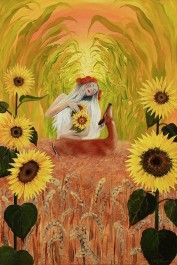And before you know it.... it is the eve of August 1st. The celtic pagan holiday of Lughnasadh. What is Lughnasadh and how do you say it you ask? Lughnasadh (LOO-nuh-suh) is the Gaelic festival that celebrates the beginning of the harvest...poised perfectly between the spring solstice and the fall equinox. Corn is a big element during the celebration, as it is ready to harvest at this time. So we hope you enjoy the corn in your shares, or for you to stop by on Saturday during our wagon corn sale. We have particular reason to celebrate this year as our crops were spared during the micro burst of hail early in the week when many of our fellow farms were not so fortunate and report heavy damage and loss.
The favorite part of the season starts to reveal itself... months of labour start to show fruit and the lingering days of summer grace us with their enticing warmth. No better life than one that is lived in the field this time of year.
Enjoy :-)
~Michael
From Wikipedia:
Lughnasadh is a Gaelic festival marking the beginning of the harvest season. Historically, it was widely observed throughout Ireland, Scotland and the Isle of Man. In Modern Irish it is called Lúnasa, in Scottish Gaelic: Lùnastal, and in Manx: Luanistyn. Traditionally it is held on 1 August, or about halfway between the summer solstice and autumn equinox. In recent centuries some of the celebrations have been shifted to the Sunday nearest this date.
Lughnasadh is one of the four Gaelic seasonal festivals, along with Samhain, Imbolc and Beltane. It corresponds to other European harvest festivals such as the Welsh Gŵyl Awst and the English Lammas.
Lughnasadh is mentioned in some of the earliest Irish literature and has pagan origins. The festival itself is named after the god Lugh. It inspired great gatherings that included religious ceremonies, ritual athletic contests (most notably the Tailteann Games), feasting, matchmaking, and trading. Traditionally there were also visits to holy wells. According to folklorist Máire MacNeill, evidence shows that the religious rites included an offering of the 'First Fruits', a feast of the new food and of bilberries, the sacrifice of a bull, and a ritual dance-play in which Lugh seizes the harvest for mankind and defeats the powers of blight. Many of the activities would have taken place on top of hills and mountains.
Lughnasadh customs persisted widely until the 20th century, with the event being variously named 'Garland Sunday', 'Bilberry Sunday', 'Mountain Sunday' and 'Crom Dubh Sunday'. The custom of climbing hills and mountains at Lughnasadh has survived in some areas, although it has been re-cast as a Christian pilgrimage. The best known is the 'Reek Sunday' pilgrimage to the top of Croagh Patrick on the last Sunday in July. A number of fairs are also believed to be survivals of Lughnasadh, for example, the Puck Fair.
Since the late 20th century, Celtic neopagans have observed Lughnasadh, or something based on it, as a religious holiday. In some places, elements of the festival have been revived as a cultural event.




